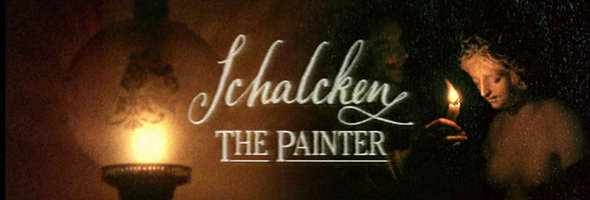
Color, 1979, 71m.
Directed by Leslie Megahey
Starring Jeremy Clyde, Maurice Denham, Cheryl Kennedy, John Justin, Charles Gray
BFI (Blu-ray & DVD) (UK RB/R2 HD/PAL)
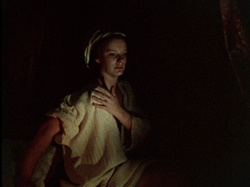 One of the most legendary and elusive BBC TV horror productions of the 1970s is this
One of the most legendary and elusive BBC TV horror productions of the 1970s is this 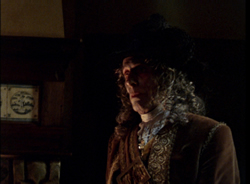 visually stunning adaptation of a supernatural tale by J. Sheridan Le Fanu, author of the classic vampire novella "Carmilla" and gothic novels like Uncle Silas. Originally aired in 1979 and repeated only once, the film (originally produced as part of the series Omnibus) left a strong impression on viewers and became a hot item on the collector's market, existing only in dire VHS copies several generations down from the source. The first commercial video release as a dual format Blu-ray and DVD package from the BFI as part of their landmark gothic festival in 2013 is a major event for fans of both television horror and English art cinema, a spooky but intoxicating gem bound to win over a new generation of admirers.
visually stunning adaptation of a supernatural tale by J. Sheridan Le Fanu, author of the classic vampire novella "Carmilla" and gothic novels like Uncle Silas. Originally aired in 1979 and repeated only once, the film (originally produced as part of the series Omnibus) left a strong impression on viewers and became a hot item on the collector's market, existing only in dire VHS copies several generations down from the source. The first commercial video release as a dual format Blu-ray and DVD package from the BFI as part of their landmark gothic festival in 2013 is a major event for fans of both television horror and English art cinema, a spooky but intoxicating gem bound to win over a new generation of admirers.
Young Flemish painter Godfried Schalcken (Clyde), a real figure here transposed into a fictional story, is an apprentice of the great Gerrit Dou (Denham) and smitten with his beautiful niece, Rose (Kennedy). Unfortunately he too poor to compete with a mysterious and sinister older man, Vanderhausen (Justin), who arranges to buy a wedding contract with Rose against her will. Schalcken refuses to elope, instead planning to become a successful artist able to buy out her marriage arrangement from her cadaverous suitor -- who never touches food and doesn't even seem to blink. Schalcken's real paintings become illustrations of the progression of the tale, which involves an eerie visit from Rose one night, years of increasingly unusual paintings, and a final encounter with the mismatched couple that affects Schalcken's work forever.
Impeccably mounted and 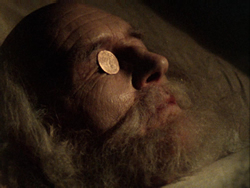 restrained in its shocks, Schalcken the Painter is a prime example of how extreme content could be slipped past the censors under the guise of art. The occasional artistic nudity may be par for the course now, but the story's climax certainly isn't; how it managed to get by is anyone's guess, but it's no wonder this stuck in so many viewers' imaginations for years. The cinematography is often incredible, recreating masters like Vermeer using natural light sources and using chiaroscuro to compose compositions worthy of the film's artistic inspirations. Also noteworthy is the excellent narration by
restrained in its shocks, Schalcken the Painter is a prime example of how extreme content could be slipped past the censors under the guise of art. The occasional artistic nudity may be par for the course now, but the story's climax certainly isn't; how it managed to get by is anyone's guess, but it's no wonder this stuck in so many viewers' imaginations for years. The cinematography is often incredible, recreating masters like Vermeer using natural light sources and using chiaroscuro to compose compositions worthy of the film's artistic inspirations. Also noteworthy is the excellent narration by 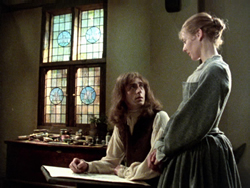 Charles Gray (as Le Fanu), one of the most distinctive voices of the era; it's tempting at first to envision him in a drawing room a la his turn as the Criminologist in The Rocky Horror Picture Show given the similar intonations here, but he was definitely the perfect choice to convey the atmosphere of romantic longing, and dread.
Charles Gray (as Le Fanu), one of the most distinctive voices of the era; it's tempting at first to envision him in a drawing room a la his turn as the Criminologist in The Rocky Horror Picture Show given the similar intonations here, but he was definitely the perfect choice to convey the atmosphere of romantic longing, and dread.
Never seen in watchable condition since the early '80s, Schalcken the Painter comes to video in fine form from the BBC archives. Rumors persisted for years that the original elements no longer existed, but that's clearly not the case. The film was originally shot in 16mm and looks authentic here, with natural minor film grain and shadowy textures intact; it's definitely a tremendous step up from any presentation before and extremely satisfying given the production standards of the time. The mono audio (with optional English subtitles) is also far clearer than the old broadcast version, finally clarifying some lines often lost entirely.
Given the short running time of the main feature, there's plenty of room here for extras -- and they're especially well chosen here. First up is the 1962 short film "The Pit," which runs just under half an hour. Directed by Edward Abraham, this adaptation of Poe's "The Pit and the Pendulum" was made one year after the Roger Corman feature and takes a completely different approach, 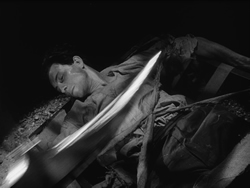 jumping back to the confined location and menace of the original story. There's no real dialogue here, just a persecuted man thrust by cloaked accusers into a harrowing fight for survival involving a swinging, razor-sharp pendulum. This was produced through the BFI's Experimental Film Fund, which means plenty of surreal POV shots and artistic flourishes that strongly recall future versions including Jan Svankmajer's partially animated short and
jumping back to the confined location and menace of the original story. There's no real dialogue here, just a persecuted man thrust by cloaked accusers into a harrowing fight for survival involving a swinging, razor-sharp pendulum. This was produced through the BFI's Experimental Film Fund, which means plenty of surreal POV shots and artistic flourishes that strongly recall future versions including Jan Svankmajer's partially animated short and 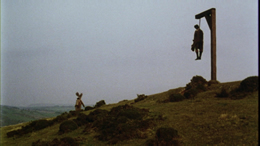 the French version two years later from Alexandre Astruc. Very creepy, nightmarish stuff, very well executed. Also included is a separate gallery of eerie production series.
the French version two years later from Alexandre Astruc. Very creepy, nightmarish stuff, very well executed. Also included is a separate gallery of eerie production series.
A third film is also included, 1981's "The Pledge," which was directed by Digby Rumsey and based on a 1908 story by the now fairly obscure Lord Dunsany. It opens with unsettling but beautiful shots of corpses including one swinging from a rope, a convicted criminal whose thieving associates have made a pact to cut his body down and place his remains in a sacred tomb to salvage his soul. As much a period mood piece and a grisly atmospheric study as a traditional narrative, it's supported most surprisingly by a fantastic, bold music score by Michael Nyman, who was in full force with his association with Peter Greenaway at the time and would score his first traditional narrative feature, The Draughtsman's Contract, just after this. The end credits music is practically worth the price of this release alone, and in a nice gesture, the once deleted final line of narration has been restored here, too. Finally we hear from Schalcken director Leslie Megahey and director of photography John Hooper, who spend a whopping 39 minutes in "Look into the Dark" discussing the film's genesis (which resulted in a three year delay so Megahey could direct it himself), the source material, and the influence of Walerian Borowczyk, especially Blanche. As usual, the enclosed booklet is essential reading as well, containing essays about all three films by Ben Hervey (who explains why Schalcken the Painter is so often believed to be a part of the BBC's Ghost Story for Christmas series, among other things), James Bell, and Vic Pratt, plus a quick note from Rumsey and a tantalizing opening script page from Schalcken indicating Le Fanu was originally supposed to appear onscreen as well at one point. Highly recommended for any fan of British horror, here represented with three decades' worth of remarkable installments.
Reviewed on October 27, 2013.


 One of the most legendary and elusive BBC TV horror productions of the 1970s is this
One of the most legendary and elusive BBC TV horror productions of the 1970s is this  visually stunning adaptation of a supernatural tale by J. Sheridan Le Fanu, author of the classic vampire novella "Carmilla" and gothic novels like Uncle Silas. Originally aired in 1979 and repeated only once, the film (originally produced as part of the series Omnibus) left a strong impression on viewers and became a hot item on the collector's market, existing only in dire VHS copies several generations down from the source. The first commercial video release as a dual format Blu-ray and DVD package from the BFI as part of their landmark gothic festival in 2013 is a major event for fans of both television horror and English art cinema, a spooky but intoxicating gem bound to win over a new generation of admirers.
visually stunning adaptation of a supernatural tale by J. Sheridan Le Fanu, author of the classic vampire novella "Carmilla" and gothic novels like Uncle Silas. Originally aired in 1979 and repeated only once, the film (originally produced as part of the series Omnibus) left a strong impression on viewers and became a hot item on the collector's market, existing only in dire VHS copies several generations down from the source. The first commercial video release as a dual format Blu-ray and DVD package from the BFI as part of their landmark gothic festival in 2013 is a major event for fans of both television horror and English art cinema, a spooky but intoxicating gem bound to win over a new generation of admirers.  restrained in its shocks, Schalcken the Painter is a prime example of how extreme content could be slipped past the censors under the guise of art. The occasional artistic nudity may be par for the course now, but the story's climax certainly isn't; how it managed to get by is anyone's guess, but it's no wonder this stuck in so many viewers' imaginations for years. The cinematography is often incredible, recreating masters like Vermeer using natural light sources and using chiaroscuro to compose compositions worthy of the film's artistic inspirations. Also noteworthy is the excellent narration by
restrained in its shocks, Schalcken the Painter is a prime example of how extreme content could be slipped past the censors under the guise of art. The occasional artistic nudity may be par for the course now, but the story's climax certainly isn't; how it managed to get by is anyone's guess, but it's no wonder this stuck in so many viewers' imaginations for years. The cinematography is often incredible, recreating masters like Vermeer using natural light sources and using chiaroscuro to compose compositions worthy of the film's artistic inspirations. Also noteworthy is the excellent narration by  Charles Gray (as Le Fanu), one of the most distinctive voices of the era; it's tempting at first to envision him in a drawing room a la his turn as the Criminologist in The Rocky Horror Picture Show given the similar intonations here, but he was definitely the perfect choice to convey the atmosphere of romantic longing, and dread.
Charles Gray (as Le Fanu), one of the most distinctive voices of the era; it's tempting at first to envision him in a drawing room a la his turn as the Criminologist in The Rocky Horror Picture Show given the similar intonations here, but he was definitely the perfect choice to convey the atmosphere of romantic longing, and dread.  jumping back to the confined location and menace of the original story. There's no real dialogue here, just a persecuted man thrust by cloaked accusers into a harrowing fight for survival involving a swinging, razor-sharp pendulum. This was produced through the BFI's Experimental Film Fund, which means plenty of surreal POV shots and artistic flourishes that strongly recall future versions including Jan Svankmajer's partially animated short and
jumping back to the confined location and menace of the original story. There's no real dialogue here, just a persecuted man thrust by cloaked accusers into a harrowing fight for survival involving a swinging, razor-sharp pendulum. This was produced through the BFI's Experimental Film Fund, which means plenty of surreal POV shots and artistic flourishes that strongly recall future versions including Jan Svankmajer's partially animated short and  the French version two years later from Alexandre Astruc. Very creepy, nightmarish stuff, very well executed. Also included is a separate gallery of eerie production series.
the French version two years later from Alexandre Astruc. Very creepy, nightmarish stuff, very well executed. Also included is a separate gallery of eerie production series.